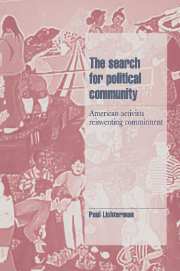Book contents
- Frontmatter
- Contents
- Acknowledgments
- 1 Personalism and political commitment
- 2 Personalized politics: the case of the US Greens
- 3 Speaking out in suburbia
- 4 Imagining community, organizing community
- 5 Culture, class, and life-ways of activism
- 6 Personalized politics and cultural radicalism since the 1960s
- 7 The search for political community
- Appendix I Choosing and studying the organizations
- Appendix II Why participant-observation was necessary
- Notes
- References
- Index
4 - Imagining community, organizing community
Published online by Cambridge University Press: 23 January 2010
- Frontmatter
- Contents
- Acknowledgments
- 1 Personalism and political commitment
- 2 Personalized politics: the case of the US Greens
- 3 Speaking out in suburbia
- 4 Imagining community, organizing community
- 5 Culture, class, and life-ways of activism
- 6 Personalized politics and cultural radicalism since the 1960s
- 7 The search for political community
- Appendix I Choosing and studying the organizations
- Appendix II Why participant-observation was necessary
- Notes
- References
- Index
Summary
Activists who went door-knocking for Hillviewers Against Toxics (HAT) felt little of the apprehension that hung over the ACES petitioners in their grocery store parking lots and suburban neighborhoods. HAT fought some of the same kinds of hazards that bedeviled Airdale – toxic air releases from industry, the threat of catastrophic explosions. HAT's community, like ACES', was enmeshed in a web of ties to one industry. But being a part of the “community” meant something different in Hillview than in Airdale; it meant among other things that no one would slam the door shut at the sight of an activist canvassing a neighborhood. HAT's construction of its community gave it a far wider mandate to do organizing work in Hillview than ACES allowed itself in Airdale. Activism in Hillview felt less risky for HAT members than it did for ACES activists in Airdale.
During my brief training as a “door-knocker” for HAT, I accompanied my “trainer,” Mrs. Davis, to a house. Her appeal to the elderly African American man living there included the word “community” at least six times. “HAT is community people who are getting the community involved,” she explained. “The organization needs you,” she affirmed, associating HAT's needs with those of the (black) community as a whole. Mrs. Davis easily launched into an impromptu pitch that an ACES member like Liz would probably never have thought of trying in her own door-knocking campaign. Mrs. Davis' seemingly unremarkable appeals to “community” took on fresh meaning after I had heard Liz carefully word her way through a rationale for why it was all right for her to be petitioning at all.
- Type
- Chapter
- Information
- The Search for Political CommunityAmerican Activists Reinventing Commitment, pp. 105 - 145Publisher: Cambridge University PressPrint publication year: 1996

